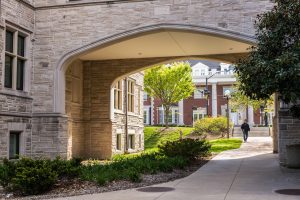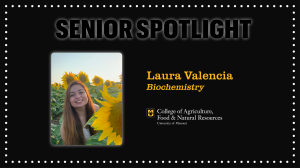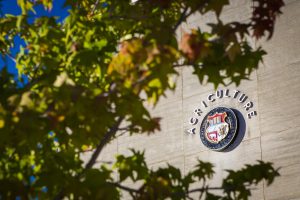Biochemistry

Nov. 10, 2021
University of Missouri and University of Georgia Receive NSF-NIFA Award to Help Fight the Soybean Cyst Nematode
MU's Lesa Beamer and UGA's Melissa Mitchum will co-direct the 4-year award, which totals $1.2 million.

June 30, 2021
Craig Schenck
To deal with relentless environmental pressures, plants produce an arsenal of structurally diverse defensive chemicals. These sometimes-complex compounds are derived from much simpler building blocks from primary metabolic pathways. Unlike well-documented diversification of plant specialized metabolic enzymes, core metabolic pathways are highly conserved and evolutionarily constrained because they serve essential metabolic functions, which makes manipulation of these pathways difficult. The expansion and alteration of core metabolism has given rise to the evolution of structurally diverse plant specialized metabolites. However, the underlying mechanisms enabling metabolic diversity and the connections linking core to specialized metabolism are not well known. These knowledge gaps…

May 24, 2021
Biochemists Receive New TRIUMPH Funding Initiative Through MU School of Medicine
A new pilot grant program led by Senior Associate Dean Bill Fay announced 30 awards to School of Medicine (SOM) investigators, including multiple awards to MU Biochemistry faculty.

May 10, 2021
Senior Spotlight: Laura Valencia
Growing up in Columbia, Laura Valencia always loved the University of Missouri. She had a chance to officially become a Tiger when she transferred to Mizzou in 2018. As she heads toward graduation, Valencia said her time at MU has been incredible. “My favorite memories at Mizzou include all of the homecoming festivities over the years, the late nights studying at Ellis, getting coffee at Memorial Union, and attending the football and basketball games,” Valencia said. “I also really enjoyed going to the student center before the pandemic hit.” When Valencia graduates in May, she will earn a degree in…

Jan. 27, 2021
Roberts, Spencer Named Society for the Study of Reproduction Distinguished Fellows
Two University of Missouri faculty were among 15 individuals recently named Society for the Study of Reproduction (SSR) Distinguished Fellows. R. Michael Roberts, Chancellor’s Professor with appointments in animal sciences and biochemistry, and Thomas Spencer, Curators’ Distinguished Professor of Animal Sciences, were both honored. This is the inaugural year of the program. From the SSR press release about the Distinguished Fellowship honor: The SSR Distinguished Fellowship is one of the highest professional scientific honors awarded for outstanding contributions to the scientific discipline of reproductive biology. The SSR Distinguished Fellowship recognizes the impact of active SSR members and their outstanding contributions…

Dec. 16, 2020
CAFNR Office of Research Recognizes Drivers of Distinction
The CAFNR Office of Research recently recognized 10 faculty members as Drivers of Distinction. The honor was given to the faculty members, listed below, who had the highest total shared credit research expenditures over the past 10 years (2011-20). David Diamond – director, Missouri Resource Assessment Partnership (School of Natural Resources) Felix Fritschi – C. Alice Donaldson Professor in Bioenergy Crop Physiology and Genetics (Division of Plant Sciences) Shibu Jose – associate dean, CAFNR Office of Research; professor (School of Natural Resources) Henry Nguyen – professor (Division of Plant Sciences) Craig Paukert – cooperative professor (School of Natural Resources) Randy…

Sep. 17, 2020
Barry Edwards

June 2, 2020
IPG PhD Students and Postdocs Selected for Webinar Series
Six University of Missouri Interdisciplinary Plant Group (IPG) PhD students and postdocs have been selected for “Summer CROPS Talks,” a webinar series for plant science researchers. This new series extends from a developing cooperation between the Center for Plant Science Innovation at the University of Nebraska-Lincoln, the Plant Sciences Institute at Iowa State and the IPG. The series provides a great opportunity for graduate students and postdocs to engage with their peers at the other institutions. The platform provides an opportunity to share graduate student and postdoc research with the plant science community. The format will be a 20-minute…

June 1, 2020
Olga J. Baker

Sep. 15, 2019
Michael Baldwin
Baldwin’s laboratory is focused on understanding how bacterial pathogens cause disease in the human population. In particular, he is studying botulinum neurotoxins, soluble proteins that readily diffuse from the site of infection to alter neuronal cell function with damaging effects on the intoxicated individual. The central theme of his research is to understand the molecular basis of protein translocation, the process by which the toxin catalytic domain is transported across the endosomal membrane bilayer to the cell cytosol. To pursue this goal, he has developed new spectroscopic and biochemical approaches to study the insertion of toxin into the membrane, which…